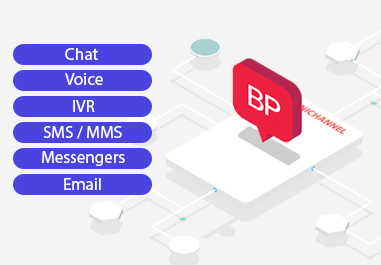The differences between contact centers and call centers are fundamental. Both are places where customers come for help and receive customer support, but their capabilities in terms of technology and how they deliver the customer experience are vastly distinct. Knowing their differences lets your brand make the best choice for reliable, accessible customer service.
So in this article, you’ll learn how call and contact centers compare. You’ll learn what both are, what they specialize in, and how they can help you. Finally, you’ll learn what to choose for your business.
What Are Call Centers?
Call centers are departments where phone agents handle inbound and outbound customer calls. These departments can operate on-site in a call center or remotely from a home office. Call centers are the first stepping stone for customers looking to contact a business.
Agents handling inbound calls help clients with account issues, tech support, scheduling, complaints, and general product and service inquiries. Meanwhile, outbound specialists focus on sales calls, lead capture, customer relations, marketing outreach, and invoice collection.
Note that call centers aren’t to be confused with call center software, a component of contact center software.
What Are Contact Centers?
Contact centers provide customer service through several communication channels. Rather than relying on just voice calls, contact centers rely on multiple different channels to allow businesses to connect with customers, hence why they are called “contact” centers. These departments use contact center as a service (CCaaS) software to provide analog and digital support.
Many confuse contact centers with call centers because they include phone in their service mix. However, phone is only one of many contact center channels—they also use email, web chat, messenger apps, SMS, live chat, social media, VoIP, and more depending on the platform.
Emphasis on Phones in Call Centers
As the name suggests, call centers focus purely on voice communication over the phone. They often extend phone abilities with Interactive Voice Response (IVR) systems to short resolution times or handle them entirely.
However, call centers lack the extensive channels, analytics, assistive AI, and software integrations contact centers offer. While call centers still cater to the 69% of consumers who prefer phone support for urgent issues, many see them as outdated due to their limited abilities. Customer service is becoming increasingly digital and mobile, with customers being on channels like messenger apps, SMS, texting, and web chat. This means the limitations of the call center software are becoming more and more apparent.
Emphasis on Advanced Analytics in Contact Centers
Using data from the different channels a customer reaches the company through, contact centers can develop more accurate customer profiles. This expanded data enables predictive support, seamless channel integration, and other tools for better customer experiences.
Contact center analytics solutions like Bright Pattern track conversations across all communication channels for a holistic view of your brand’s customer interactions. This in-depth interaction data makes sentiment analysis, KPI measuring, and performance monitoring easy with digestible data visualizations.
Self-Service in Call Centers
81% of customers try to handle issues themselves before contacting support services. Due to queue times and the speed of self-service, most people prefer to solve issues themselves.
But most call centers have a frustratingly limited ability to provide self-service. The only option available is usually an IVR system lacking the conversational abilities of its contact center counterparts.
These systems are touch-toned based, only accepting limited 1-2 word voice commands for menu navigation. And if a customer makes a wrong selection, restarting the call is often easier than slowly navigating back to the main menu.
Self-Service in Contact Centers
Contact center software excels in self-service. Thanks to AI integration, contact center self-service platforms can readily replace human agents in many areas without compromising customer satisfaction.
With advanced speech processing powered by machine learning and AI, organizations can outsource many of the simple and repetitive tasks agents have to perform to automation (resetting passwords, fetching account info, fixing basic customer errors, etc.). Utilizing speech processing, the conversational IVR system lets customers use their natural language to navigate the IVR.
For instance, contact centers offer true conversational IVR in stark contrast to the prompt-based analog systems of a call center. Conversational IVR uses machine learning to understand complex requests on its own, not relying on scripted responses created by the support team.
This same conversational ability manifests in chatbots, which can process complex conversations like humans. And even in the scenario that conversational systems are not enough, the omnichannel nature of the contact center makes the transition to a human agent seamless.
Scaling Differences Between Call and Contact Centers
Scalability is a major factor in the decision between call center vs. contact center.
Thanks to their lack of automated systems, call centers can only scale with more agents. When call numbers mount and agents are overwhelmed with inbound, the only solution is an expensive hiring spree.
Aside from the monetary costs of adding more employees, the labor cost of training new agents is significant. Managers must divide their attention between monitoring the performance of existing agents and onboarding new ones. But thanks to their advanced technologies, contact centers don’t suffer the same scaling issues.
First, AI-powered self-service IVR and chatbot systems handle large amounts of agent work alone. Outsourcing customer support to AI lets organizations offset the need for additional staff by a large margin.
Second, contact center technology greatly increases the productivity of current agents. Assistive technology like response suggestions, predictive support, and automatic translations make one agent as productive as two or three others combined. Scaling this effect to an entire contact center means large reductions in staffing needs without compromising service standards.
Finally, the contact center AI makes onboarding new agents far more efficient. The same integrated dashboards and response suggestions that boost current agent productivity make the job far easier for new agents (who would otherwise be overwhelmed by a flurry of calls in the call center).
This technology has the bonus effect of improved agent morale and greater retention rates.
Efficiency Differences Between Call Centers and Contact Centers
Whatever the model, a customer service center’s ability to assist customers depends on its available toolset. If technical limitations restrict companies’ ability to optimize their support process, they’re condemned to the growing inefficiencies as their enterprise scales.
Contact centers have far more features than call centers, without exception. A contact center integrates different channels, technologies, and third-party integrations to provide clients with prompt, high-quality service—all while making support easier and less expensive.
Efficiency boosting features like skill-based routing, conversational IVR, and predictive dialing simply aren’t within the abilities of the analog technology call centers depend on.
Choose Bright Pattern for Your Contact Center
So call center or contact center?
As you can see, contact centers offer far greater capabilities than call centers. While contact centers use cutting-edge technology to deliver superior service across all channels, call centers rely on increasingly-obsolete analog tech to get by.
Relying on an inferior support system creates poor experiences for customers frustrated with slow-dial menus and long wait times. This can be disastrous for your brand since 53% of consumers will stop doing business with a company after a bad support experience.
So invest in a contact center that not only scales with your organization but also provides seamless experiences along the way. Book a demo with Bright Patten today.





